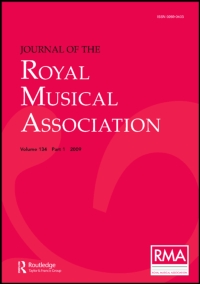No CrossRef data available.
Article contents
Curiosities of the Keyboard and the Staff
Published online by Cambridge University Press: 01 January 2020
Extract
Mr. Chairman, Ladies, and Gentlemen,—For some years I have been endeavouring to apply to the keyboard and the staff the principle which guided Sir Isaac Newton in his astronomical discoveries—viz., “thoughtful attention to little things.” To this principle it is said Sir Isaac attributed all his success.
- Type
- Research Article
- Information
- Copyright
- Copyright © Royal Musical Association, 1894
References
∗ I ought to have seen (which at that time I did not) that the rings of the G and F clefs being reflective on the second tines of the staves supplied the key to the situation, not only to these notes, bat also to the reflective aspects of A and E and 6 and DGoogle Scholar
∗ It is very likely that Sir George had reference to only a few studies, for the second part appeared in 1810, published by Breitkopf and Hartel (Grove's Dictionary, Vol I., p. 414).Google Scholar
∗ Beethoven, Mass in C, p. 200 (8vo, Novello).Google Scholar
∗ A young student will find valuable aid to a knowledge of inversions of common chords, if on the keyboard he plays first these fourths, and then adds major or minor thirds above or below; at the same time naming them first or second inversions as the case may be, together with the root thus: ![]() Second inversion of B♭ major and first inversion of G minor.Google Scholar
Second inversion of B♭ major and first inversion of G minor.Google Scholar
∗ Arpeggios and passing notes are omitted in order that the key chords may be more readily discerned and compared with example 25, bar 4. Also example 25, bar 4, compared with bars 16 and 15, shows Beethoven's ascent from C minor to E♭ major; and Schumann's, from C major to E minorGoogle Scholar
∗ The above exposition of the principle of reflection applied to the keyboard and the staff is part of a copyright work now in the press, entitled “Curiosities of the Keyboard and the Staff,” particulars of which will be sent by the Author, “Aysgarth,” 55, Leander Road, Brixton Hill, S.W., on receipt of an addressed post card. Publisher : Reeves, 185, Fleet Street.Google Scholar


